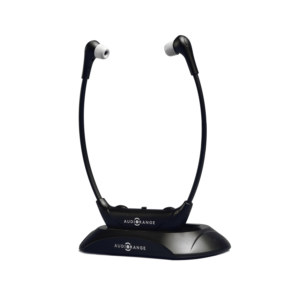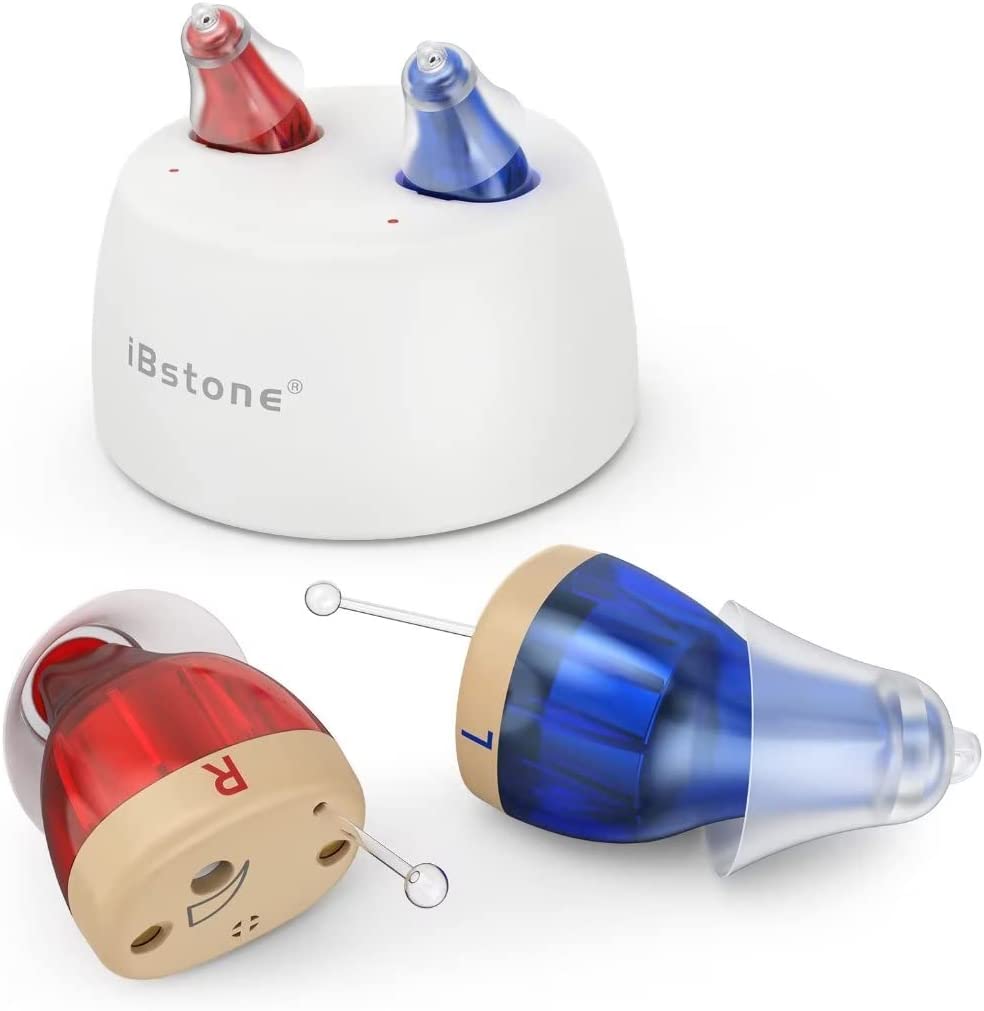Best Hearing Amplifiers For 2023
AgingInPlace.org keeps our resources free by working as an affiliate partner with some companies mentioned on our site. These partnerships or the commission we may earn do not affect our opinions or evaluations of the products we mention. Our reviews are solely based on our research methodology and from input from our AgingInPlace.org Advisory Board. Learn more about our ad policies.
Best Hearing Amplifiers For 2023
Products carousel
If you’re seeking hearing loss solutions, you may be wondering what your options are. It’s important to start by understanding the difference between hearing aids and hearing amplifiers, also known as personal sound amplification products (PSAPs). These hearing assistance devices may appear similar, but they are distinctively different.
“A prescription hearing aid treats your specific type of hearing loss,” explained Samantha Deker, a personal care coordinator at Connect Hearing in Denver, Colorado. “It will adjust frequencies that you cannot hear and make things clearer. An amplifier will only increase the volume of everything coming in. So if you cannot hear high frequencies, you still will not be able to hear them with an amplifier.”
While hearing aids were once only available by prescription, the FDA regulated over-the-counter (OTC) hearing aids for treatment of mild to moderate hearing loss in late 2022. Unlike prescription and OTC hearing aids, PSAPs are not FDA regulated.
Personal sound amplification products are wearable products that use a microphone, enabling you to hear nearby sounds, and are best suited for people who need better sound for recreation. If you can’t afford prescription hearing aids and have mild to moderate hearing loss, consider over-the-counter hearing aids.
Best Hearing Amplifiers We Reviewed:
- Editor’s Choice: AudioRange ITE-1000 Wireless TV Headset
- Best Short-Term Wear: Williams Sound PockeTalker
- Most Discreet: iBstone Rechargeable Hearing Amplifier
- Best Style: Neosonic Rechargeable Hearing Amplifier
Pros
-
Easy set up, no pairing required for most TVs
-
Mic and sound amplifier allow for better conversations without taking headphones off
-
Comfortable, lightweight in-ear design
-
Eight hours of battery
-
No lip-sync delay
Cons
-
In-ear headphones aren’t compatible with hearing aids
If you’re struggling to hear the dialogue of your favorite movie or TV show, this is our top pick. The AudioRange ITE-1000 are in-ear TV headphones that enable you to listen to the TV without turning up the volume to uncomfortable levels.
We like the fact that these headphones sit comfortably inside your ear canal. Unlike earbuds, your ears won’t get sore over time. They also come with a mic and sound amplifier, meaning that you’ll be able to have an entire conversation without needing to take them off. In addition, you can mute background noise from the TV and amplify the sound around you to a natural level.
The AudioRange ITE-1000 Wireless Headphones work with almost all TVs and devices—you won’t have to struggle with complicated setup or pairing steps. They also have a range of 100 feet, which means you can watch TV from an enjoyable distance or get up without missing what was said.
Editor’s Choice
What Is Editor’s Choice?
Our team of editors and writers choose a product from each article that stands out based on our extensive research of the products we review. While it may not always be the highest-scoring product in the lineup, we’ve chosen the product based on its overall value to our audience.
Why We Chose This Product:
The ITE-1000 Wireless Headphones are our top pick for anyone struggling to hear movie or TV show dialogue. They’re comfortable and get the job done at an affordable price.
Pros
-
Easy to use straight out of the box
-
Good sound amplification for the price
-
Volume and tone controls
-
Purchase includes 20 AAA batteries
-
Device clips onto a belt
Cons
-
Batteries are not rechargeable
-
Uncomfortable over long periods of wear
-
Amplifies all sound
With a no-frills design featuring on-ear headphones and a detachable mic, it’s clear how to use this hearing amplifier as soon as you take it out of the packaging. The volume control is on the device itself and allows users to adapt to different environments quickly. The Wiliams Sound PockeTalker also includes tone control, which allows you to adjust for low- or high-frequency sounds.
The on-ear headphones are comfortable to wear for the short-term, though users may find that they’re cumbersome to wear after a few hours. Overall, these provide an ideal signal to noise ratio and a dynamic sound range.
Pros
-
Only three to six hours of charging for 24-hour charge
-
Lightweight
-
Adjustable sound volume and active noise reduction
-
Subtle design
-
Available in three sizes for comfortable wear
Cons
-
No alternative color options
-
May be too large for some ears
-
Must use small tool to adjust the volume
Some hearing amplifier choices are clunky to use, but fortunately, there are choices available for people who want a subtle hearing amplifier device that doesn’t draw attention.
The iBstone Rechargeable Hearing Amplifier is our top choice if you’re looking for a discreet hearing amplifier. Because of its small and lightweight form, it’s suitable for long-term use. It also comes with several ear domes in different sizes, so that you can find the right fit for you.
We like that the battery life lasts 24 hours, meaning you never have to worry about your hearing amplifiers failing you in the middle of the day. In addition, the hearing amplifier comes with an easy-to-use charging station and only requires a maximum of six hours to charge—so they’ll be ready to go overnight.
The iBstone Rechargeable Hearing Amplifier offers built-in noise reduction and has preprogrammed adjustable hearing settings for different environments. In addition, you can customize the volume control on each ear amplifier with the provided unique screwdriver tool. While this method of changing the volume may work for some, older adults or anyone who experiences reduced hand dexterity may find using the volume tool challenging to maneuver given its size.
Best Style
Neosonic Rechargeable Hearing Amplifier to Aid TV Watching, Wireless Neckband Headphones for Seniors & Adults
Pros
-
Slick and sophisticated design
-
Ability to soften background noise
-
Easily adjustable volume
-
Rechargeable
-
Wireless microphone gives multiple applications
Cons
-
Not as subtle as in-ear hearing amplifier devices
-
Wired earphones may be irritating for long-term use
The Neosonic Rechargeable Hearing Amplifier bridges the gap between subtle and sophisticated design. The wired earphones come with a thin neckband that lays comfortably on top of your shoulders, reducing the burden on your ears. Although the neckband may seem unnecessary at first, it’s an easy way to adjust the volume of your hearing amplifiers on the fly. Unlike in-ear hearing amplifiers, which require you to take them out and use a unique tool to adjust the volume.
We like the fact that the wire is adjustable, so it’s not uncomfortable against your skin. You’ll also be able to choose from three different earbud sizes.
Lastly, the Neosonic is notable for the wireless microphone that it comes with, giving the device multiple applications. For instance, you can place the microphone near your TV for a better listening experience, as you won’t need to turn up the volume for crystal clear sounds. You can also place the microphone nearby when you’re having a conversation to increase sound quality.
While not completely noise canceling, the device will soften background noises, so that you can focus on who or what you want to hear better.
Hearing Aids vs. Hearing Amplifiers
Hearing Aids
In the U.S., hearing aids are considered Class 1 medical devices and are regulated by the FDA. Hearing aids are highly technical and customized to a person’s particular type and severity of hearing loss, including tinnitus (ringing or other noises in the ears that can be constant, pulsatile, or intermittent). Hearing aid models may also include advanced features such as selective noise reduction, Bluetooth capabilities, and linked mobile phone apps, which means they can be quite expensive. They are designed to treat most types of hearing loss from mild to profound and may also treat one-sided (unilateral) hearing loss.
Hearing aids come in a multitude of style options. Some types include behind-the-ear (BTE), receiver-in-canal (RIC), and in-the-ear (ITE) designs. The style that is best suited for you depends on your personal preference, ear anatomy, and type of hearing loss. BTE aids are the largest type and contain all components within a case which sits behind the ear. RIC aids are slightly smaller because the receiver portion of the device sits in the ear canal, connected by a wire to a casing behind the ear. ITE models are the smallest, most discreet options and may occupy the outer ear canal space, sit completely in the canal (CIC), or even be invisible in the canal (IIC).
For the most customized hearing loss solution, you should purchase hearing aids through a hearing specialist or audiologist with a prescription. These offices will generally perform testing, make recommendations, help set up and customize your hearing aids, and assist with future adjustments in order to meet your specific needs. An AgingInPlace.org survey of 1,000 hearing aid users showed that most customers prefer to go to a specialist and manage their hearing aids through an office rather than shop online or do adjustments themselves.
Over-the-Counter Hearing Aids
The FDA’s recent regulation of hearing aids for over-the-counter (OTC) sales offers more accessibility to the general public. While OTC hearing aids are meant to treat mild to moderate perceived hearing loss and don’t require in-office testing or a prescription, they contain similar technology found in prescription hearing aids, generally at less cost to the user. Some online retailers offer online hearing screening tests to help determine if OTC hearing aids will be beneficial. OTC hearing aids are generally purchased at the discretion of the consumer with little input from a hearing specialist.
Hearing Amplifiers
Hearing amplifiers are not meant to treat hearing loss. Rather, they are meant to amplify the volume of sounds for those with normal hearing, often from far away in outdoor settings such as bird watching or hunting. They may also be used to hear a TV or music when the user would prefer not to turn the volume up, perhaps because it would bother others in the home. Like hearing aids, hearing amplifiers come in BTE, RIC, and ITE styles.
Unlike hearing aids, which use advanced algorithms to selectively modify and enhance some sounds, hearing amplifiers indiscriminately magnify all sounds at all frequencies. Because they’re considered electronics rather than medical devices, PSAPs are not regulated by the FDA, so they are not subject to safety or quality testing. Not surprisingly, hearing amplifiers carry a much smaller price tag than hearing aids. Some people have been able to successfully use hearing amplifiers for very mild, beginning-stage hearing loss, but again, this is not an approved or intended purpose. It’s also possible to damage your hearing or worsen tinnitus with hearing amplifiers.
Tony Brown, 50, of Lakewood, Colorado, is a hearing aid user who spoke with our team. He said he has used both hearing amplifiers and hearing aids for his mid-frequency profound hearing loss. As you might expect, he found that hearing amplifiers were not complex enough to successfully treat his hearing loss. “They just made unclear speech louder so I still couldn’t understand anyone,” he said. “Also, they had about a one-second delay which was very frustrating.” He ultimately sought treatment from an audiologist and now uses Phonak Audéo RIC hearing aids.
Can Wireless Earbuds Be Used as Hearing Amplifiers?
Recently, the media has been abuzz with talk of using wireless earbuds, like Apple AirPods, as PSAPs. These devices connect to audio-producing instruments like TVs and speakers via Bluetooth. A recent Japanese study found that Apple AirPods Pro improved speech intelligibility in test subjects in certain environments. But the effectiveness of the AirPods was reduced once background noise was introduced. The authors concluded that “Apple AirPods Pro might have the potential to be a hearing assistive device for adults with mild to moderate hearing loss.” The study was very small (only 21 subjects) and considered only a few listening scenarios. Certainly, more research and testing is needed before wireless earbuds can be recommended for safe hearing amplification.
What to Consider When Buying a Hearing Amplifier
Large retailers such as Walmart, Costco, Best Buy, and Amazon sell hearing amplifiers from popular brands like MEDca, Doosi, KIBVOE, NewEar, and eTopeak. Prices can range from around $50 to nearly $800. The more expensive models may come with rechargeable batteries, Bluetooth streaming, and corresponding mobile phone apps for adjustments. These same retailers also carry OTC hearing aids.
| FEATURE | HEARING AIDS | HEARING AMPLIFIERS |
|---|---|---|
| AMPLIFIES SOUND VOLUME | ✅ | ✅ |
| SELECT SOUND MODIFICATION | ✅ | ❌ |
| CLARIFIES SOUND | ✅ | ❌ |
| TREATS HEARING LOSS | ✅ | ❌ |
| TINNITUS RELIEF | ✅ | ❌ |
| SELECTIVE NOISE REDUCTION | ✅ | ❌ |
| BLUETOOTH CAPABILITY | ✅ | ❌ |
| MOBILE PHONE APP | ✅ | ❌ |
| FDA REGULATED | ✅ | ❌ |
| PRESCRIPTION REQUIRED | Depends on brand | ❌ |
| COST | $900–$6,000+ | $50–$800 |
| FEATURE | ||||||||||||||||||||||||||||||||||||||||||||||||||||||||||||||||||
| AMPLIFIES SOUND VOLUME | HEARING AIDS | ✅ | HEARING AMPLIFIERS | ✅ |
|---|
| SELECT SOUND MODIFICATION | HEARING AIDS | ✅ | HEARING AMPLIFIERS | ❌ |
|---|
| CLARIFIES SOUND | HEARING AIDS | ✅ | HEARING AMPLIFIERS | ❌ |
|---|
| TREATS HEARING LOSS | HEARING AIDS | ✅ | HEARING AMPLIFIERS | ❌ |
|---|
| TINNITUS RELIEF | HEARING AIDS | ✅ | HEARING AMPLIFIERS | ❌ |
|---|
| SELECTIVE NOISE REDUCTION | HEARING AIDS | ✅ | HEARING AMPLIFIERS | ❌ |
|---|
| BLUETOOTH CAPABILITY | HEARING AIDS | ✅ | HEARING AMPLIFIERS | ❌ |
|---|
| MOBILE PHONE APP | HEARING AIDS | ✅ | HEARING AMPLIFIERS | ❌ |
|---|
| FDA REGULATED | HEARING AIDS | ✅ | HEARING AMPLIFIERS | ❌ |
|---|
| PRESCRIPTION REQUIRED | HEARING AIDS | Depends on brand | HEARING AMPLIFIERS | ❌ |
|---|
| COST | HEARING AIDS | $900–$6,000+ | HEARING AMPLIFIERS | $50–$800 |
|---|
Bottom Line
With approximately 48 million Americans reporting some degree of hearing loss, it is the third most common chronic physical condition in the U.S. This is a major public health concern considering that untreated hearing loss is linked to social isolation, depression, cognitive decline, and even dementia. That’s why it’s important to understand your options. Hearing aids are meant to treat hearing loss and have much more advanced, customizable features than hearing amplifiers. While hearing aids are more expensive than hearing amplifiers, they are also regulated by the FDA. Hearing amplifiers are not and can damage your ears if not used carefully. Prescriptions are not required for any hearing amplifiers and some hearing aids, but for severe hearing loss or a more customized solution, a prescription from an audiologist is recommended.
Frequently Asked Questions
-
Yes, hearing aids are considered Class 1 medical devices and are regulated by the FDA. Hearing aids are highly technical and customized to a person’s particular type and severity of hearing loss. They are designed to treat most types of hearing loss from mild to profound and may also treat one-sided (unilateral) hearing loss.
-
Hearing amplifiers, also known as PSAPs, are designed to amplify the volume of all sounds for those with normal hearing. This can include bird watching, hunting, watching TV, or playing music. They are not meant to treat hearing loss.
-
It depends. If you only need amplification in one ear, then one should suffice. However, you should wear two if you require hearing loss treatment in both ears. There will be a significant advantage with spatial awareness, sound localization, and clarity, especially in noisy environments.
-
Costco sells both. With FDA regulation of OTC hearing aids, Costco now also sells hearing aids designed for mild to moderate hearing loss.
-
While hearing aids can’t help restore your hearing loss, they can help treat your hearing loss by making speech and sound easier to understand.
WRITTEN BY
Lauren Sherman, M.S., is a health content writer with a master's degree in human genetics from the University of Colorado Anschutz Medical Center, laboratory experience at National Jewish Health, and clinical experience at Children’s Hospital Colorado. She has extensively researched products to help those wanting to age in place such as medical alert systems, walk-in tubs, adjustable beds, and oxygen concentrators.
View AuthorMEDICALLY REVIEWED BY
Brian Murray earned a bachelor's of science degree in Speech Language Pathology and Audiology in 2010 from Ithaca College. He is licensed to dispense hearing aids in New York, North Carolina, and Virginia, where he has worked in both private practice and retail clinics. He is currently a workshop consultant with Alpaca Audiology.
View Reviewer- Hearing Loss Facts and Statistics | HLAA
- Too Loud! For Too Long! | CDC
- Hearing Loss: A Common Problem for Older Adults | NIA
- Applications of Direct-to-Consumer Hearing Devices for Adults with Hearing Loss: A Review | PMC
- Smartphone-bundled earphones as personal sound amplification products in adults with sensorineural hearing loss | Cell.com
- The Hidden Risks of Hearing Loss | Johns Hopkins Medicine
Do you want to cite this page? Use our ready-made cite template.



